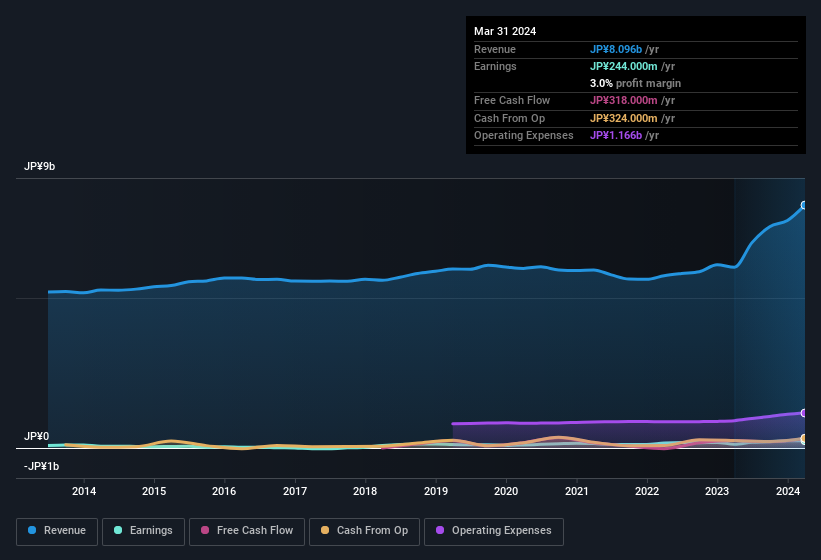- Japan
- /
- Commercial Services
- /
- TSE:4664
There May Be Underlying Issues With The Quality Of Japan Reliance Service's (TSE:4664) Earnings

Japan Reliance Service Corporation's (TSE:4664) robust earnings report didn't manage to move the market for its stock. Our analysis suggests that this might be because shareholders have noticed some concerning underlying factors.
View our latest analysis for Japan Reliance Service

Examining Cashflow Against Japan Reliance Service's Earnings
In high finance, the key ratio used to measure how well a company converts reported profits into free cash flow (FCF) is the accrual ratio (from cashflow). To get the accrual ratio we first subtract FCF from profit for a period, and then divide that number by the average operating assets for the period. The ratio shows us how much a company's profit exceeds its FCF.
As a result, a negative accrual ratio is a positive for the company, and a positive accrual ratio is a negative. While it's not a problem to have a positive accrual ratio, indicating a certain level of non-cash profits, a high accrual ratio is arguably a bad thing, because it indicates paper profits are not matched by cash flow. Notably, there is some academic evidence that suggests that a high accrual ratio is a bad sign for near-term profits, generally speaking.
Japan Reliance Service has an accrual ratio of -0.11 for the year to March 2024. That indicates that its free cash flow was a fair bit more than its statutory profit. To wit, it produced free cash flow of JP¥318m during the period, dwarfing its reported profit of JP¥244.0m. Japan Reliance Service shareholders are no doubt pleased that free cash flow improved over the last twelve months. Having said that, there is more to the story. The accrual ratio is reflecting the impact of unusual items on statutory profit, at least in part.
Note: we always recommend investors check balance sheet strength. Click here to be taken to our balance sheet analysis of Japan Reliance Service.
The Impact Of Unusual Items On Profit
Surprisingly, given Japan Reliance Service's accrual ratio implied strong cash conversion, its paper profit was actually boosted by JP¥72m in unusual items. While it's always nice to have higher profit, a large contribution from unusual items sometimes dampens our enthusiasm. When we analysed the vast majority of listed companies worldwide, we found that significant unusual items are often not repeated. And that's as you'd expect, given these boosts are described as 'unusual'. If Japan Reliance Service doesn't see that contribution repeat, then all else being equal we'd expect its profit to drop over the current year.
Our Take On Japan Reliance Service's Profit Performance
Japan Reliance Service's profits got a boost from unusual items, which indicates they might not be sustained and yet its accrual ratio still indicated solid cash conversion, which is promising. Based on these factors, we think it's very unlikely that Japan Reliance Service's statutory profits make it seem much weaker than it is. So while earnings quality is important, it's equally important to consider the risks facing Japan Reliance Service at this point in time. In terms of investment risks, we've identified 3 warning signs with Japan Reliance Service, and understanding these should be part of your investment process.
In this article we've looked at a number of factors that can impair the utility of profit numbers, as a guide to a business. But there is always more to discover if you are capable of focussing your mind on minutiae. Some people consider a high return on equity to be a good sign of a quality business. While it might take a little research on your behalf, you may find this free collection of companies boasting high return on equity, or this list of stocks with significant insider holdings to be useful.
If you're looking to trade Japan Reliance Service, open an account with the lowest-cost platform trusted by professionals, Interactive Brokers.
With clients in over 200 countries and territories, and access to 160 markets, IBKR lets you trade stocks, options, futures, forex, bonds and funds from a single integrated account.
Enjoy no hidden fees, no account minimums, and FX conversion rates as low as 0.03%, far better than what most brokers offer.
Sponsored ContentNew: Manage All Your Stock Portfolios in One Place
We've created the ultimate portfolio companion for stock investors, and it's free.
• Connect an unlimited number of Portfolios and see your total in one currency
• Be alerted to new Warning Signs or Risks via email or mobile
• Track the Fair Value of your stocks
Have feedback on this article? Concerned about the content? Get in touch with us directly. Alternatively, email editorial-team (at) simplywallst.com.
This article by Simply Wall St is general in nature. We provide commentary based on historical data and analyst forecasts only using an unbiased methodology and our articles are not intended to be financial advice. It does not constitute a recommendation to buy or sell any stock, and does not take account of your objectives, or your financial situation. We aim to bring you long-term focused analysis driven by fundamental data. Note that our analysis may not factor in the latest price-sensitive company announcements or qualitative material. Simply Wall St has no position in any stocks mentioned.
About TSE:4664
Japan Reliance Service
Provides various security, building maintenance, human resource, general construction, condominium management services in Japan.
Adequate balance sheet average dividend payer.
Market Insights
Community Narratives



